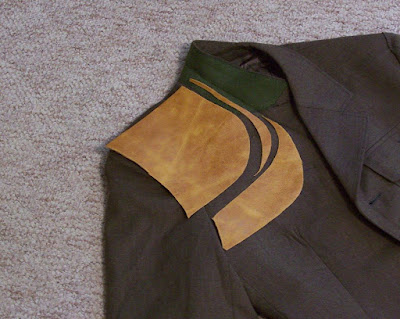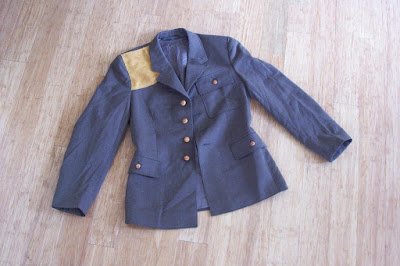While searching for a replacement for my worn-out Swiss army jacket, which I've been wearing as a winter coat for nine years, I came across a Slovakian army jacket on sale for 10USD. Unfortunately it's too light for winter, but similar in weight to a high-quality sportcoat, and the extra-small is a pretty good fit on me.
It has one major drawback: It is, at a glance, somewhat similar to an "alpha" jacket, the everyday non-combat uniform of U.S. Marines. But I wanted a sportcoat, thus this project follows.
The first and most obvious step is to get rid of the sleeve insignia, which is accomplished quickly with a seam ripper and tweezers to pull out all the bits of stitching.
Next I removed the right breast pocket, which isn't normally seen on civilian sportcoats except those specialized for hunting. The end goal here is a sportcoat derived from a hunting coat.
Unfortunately, the stitching that attaches the pocket to the coat also seems to be connected with the front dart. This is going to need to be closed up at some point.
The epaulettes are made from thick, stiff, laminated layers of canvas with a self-fabric facing. They can't be simply cut off; I had to open the seams to remove them.
I'm not used to sewing fabric or buttons, so I had to ask my mom for instructions on some of the following steps. She told me to close the seams up with a blind stitch, but I really failed at making it "blind." It should hold the sleeve on, though.
All the buttons are replaced with leather ones. (Well, faux-leather, since we're on the cheap.) Since major retailers like Jo-Ann don't sell this type individually, two cards of the larger buttons are required, plus one of the smaller. They're stitched heavily with button/carpet thread and tied off several times.
Elbow patches are essential on a creaky old professor's jacket. This is a small garment piece from Tandy which I ordered after a brief conversation with the store clerks, who were nice enough to e-mail me a photo of their recommendations, and luckily one was an almost identical color to the buttons as well as having a nice aged, grainy texture. I actually bought several pieces, as this coat will have a shoulder patch as well.
I based the dimensions (4.75 by 5.75 inches) on those of an old Orvis travel jacket.
The Tandy piece, which is 8.5 by 11 inches (same as a standard sheet of copy paper) was a bit too small to cut two patches that were exactly the same size as the Orvis one, so after some consideration I went for making mine the same length but a half-inch narrower.
The pattern is cut along straight lines, folded into quarters and trimmed to try and make it more symmetrical.
It's then traced onto the flesh side of the leather and cut in the usual manner.
The pattern shifted in and up a hair more than 1/8 inch for the guidelines, and holes pre-punched.
The patch is centered horizontally on the sleeve seam and vertically through trial and error by checking where the elbow is located along the sleeve along a range of movement with the arm bent.
Sewing without going through the jacket's lining is trickiest, but sewing through the lining risks misaligning the lining and distorting the jacket's fit as well as exposing the stitches to internal wear. So on the whole, you want to do the former if at all possible. The leather is folded with the shell fabric pinched between. I then reach into the sleeve and pull the lining out of the pinch. Then I slide the needle in pointing a bit backward until it goes through the shell, orient it so the point presses against the shell and slowly drag the tip back until it's pointing at the next stitch hole in the leather, and push forward again. This way a bit of the shell fabric is caught in the stitch. I did have to redo many, many stitches along the way, and the needle often winds up exiting the leather a tiny bit in front of or behind the pre-punched hole.
The shoulder patch is the last major alteration. (It's strange if you think about it, because the shoulder patch is meant to protect against wear and tear from firing a rifle, but I've never seen one on a military jacket. I suppose combat jackets are expected to wear out all over and be replaced before that becomes an issue, while sportcoats are more curated, and obviously dress jackets like these don't need any such thing.) I cut the pattern to run all the way from the sleeve to the crease of the lapel and collar, and estimated its length based on several photos of sportcoats found online. I cut it to the maximum length seen in these photos, which is roughly two sevenths of the jacket's length.
As you can see, this is kind of large.
After examining a few more photos, I re-trimmed the leather to a length that's closer to two ninths, and made it a tiny bit narrower so that it would be easier to fit between the sleeve and collar.
The shoulder patch is punched and sewn in much the same way as the elbow patches, except that just below the collar were several points where the coat's layers were sewn so close together that the whole becomes extremely stiff and it wasn't possible to go through only the top layer, so the patch stitches go all the way through here. Luckily, the tight assembly in this area means that sewing all the way through won't cause distortion or affect the fit. I may, however, hot-glue some thin patches of material here just to protect the stitches from internal wear.
Although not an alteration per se, closing the dart is the final important step. With more coaching from Mom, I tried to do a proper blind stitch here, but still decided to knot the ends on the outside, which leaves them visible.






















No comments:
Post a Comment